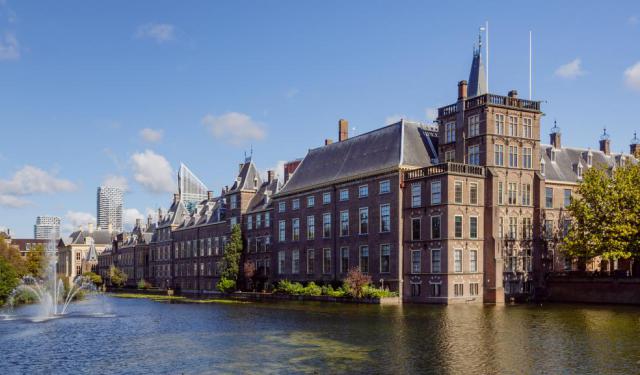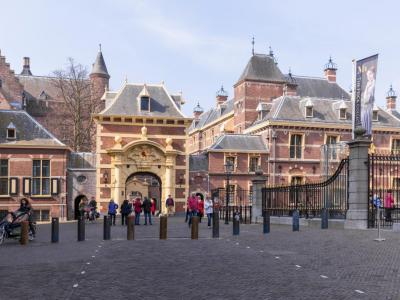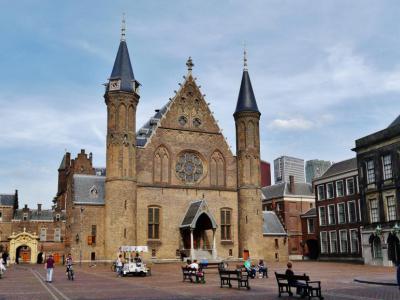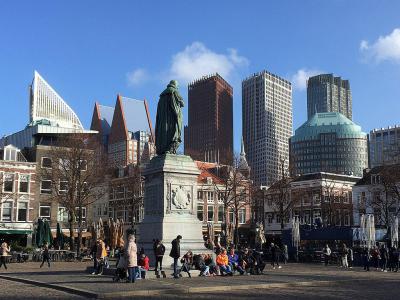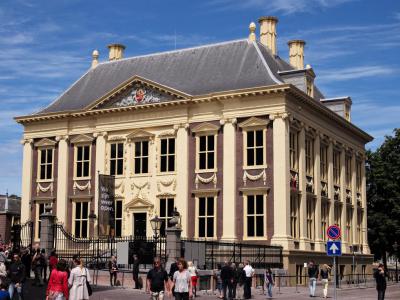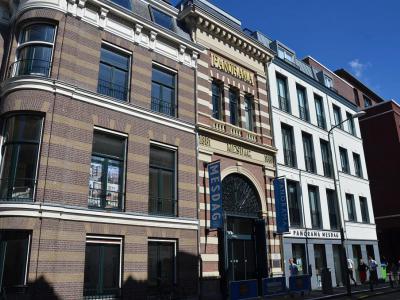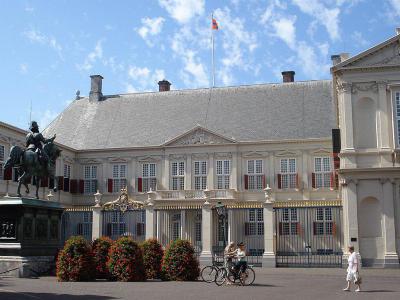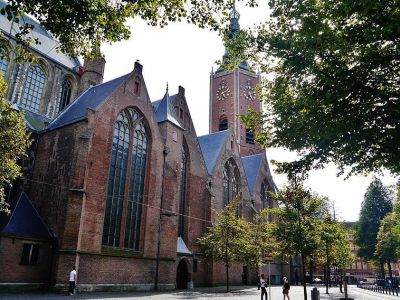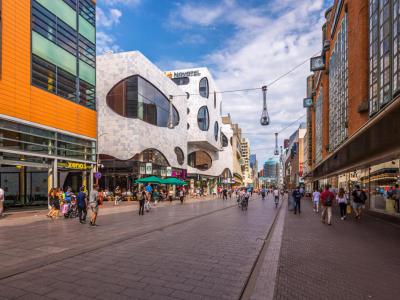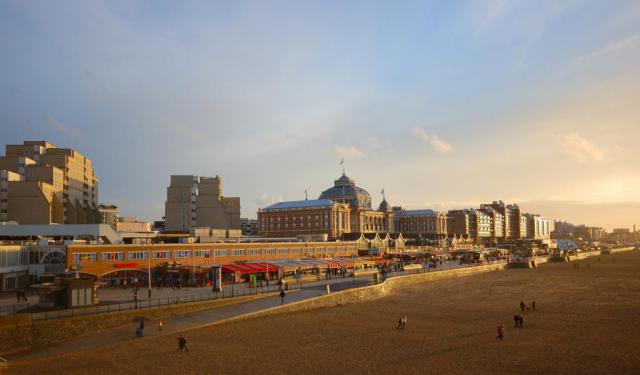The Hague Introduction Walking Tour (Self Guided), Hague
While the official capital of the Netherlands is Amsterdam, The Hague is the country's de facto capital and administrative center.
Little is known about the origin of The Hague as such. What is certain is that it was founded by one of the last counts of the House of Holland, Floris IV, who already owned two residences in the area, but had his eye set on a waterfront property near the pond Hofvijver. He purchased his dream house in 1229 and died in a tournament in 1234.
His son, William II, moved into the court and soon thereafter was elected King of the Romans. William promptly gave the Court a redo and called it the Inner Court (Binnenhof) before he died a short time later.
The Inner Court was first mentioned as Die Haghe in 1242. In the 15th century, the name “des Graven hage” came into use, literally meaning The Count's Wood, Private Enclosure, or Hunting Grounds. Today, the city uses the Dutch name “Den Haag” in all its communications.
The Hague has endured 700 years. In 1806, during the era when the Kingdom of Holland was under French control, it was granted city rights by Louis Bonaparte, and later became a significant administrative center for the Netherlands, particularly after the separation of Belgium in 1830 and the government's increasing role in Dutch society after 1850.
During World War II, Hitler's coastal fortifications Atlantic Wall erased many older neighborhoods. The Allied air raids, and of course, the horrors of the Jewish holocaust added further gruesome experiences. But the city survived. After the war, The Hague undertook massive rebuilding and expansion.
William's Inner Court and the Knights' Hall (Ridderzaal) are now the seat of government. The Inner Court is surrounded by landmark buildings such as the Great Church (built in 1399), the New Chuch (built in 1654), the 16th-century Royal Palace (Noordeinde), and the Renaissance-style Town Hall of 1564.
The city's museums provide a smorgasbord of collections. One such is the Mauritshuis Royal Picture Gallery holding paintings by Rembrandt, Vermeer, Steen, and more. The Mesdag Museum houses the incredible Mesdag Panorama.
We hereby invite you to embark on a journey to this captivating city and the Netherlands' political hub. Take our self-guided introductory tour and experience the beauty and diversity of The Hague for yourself!
Little is known about the origin of The Hague as such. What is certain is that it was founded by one of the last counts of the House of Holland, Floris IV, who already owned two residences in the area, but had his eye set on a waterfront property near the pond Hofvijver. He purchased his dream house in 1229 and died in a tournament in 1234.
His son, William II, moved into the court and soon thereafter was elected King of the Romans. William promptly gave the Court a redo and called it the Inner Court (Binnenhof) before he died a short time later.
The Inner Court was first mentioned as Die Haghe in 1242. In the 15th century, the name “des Graven hage” came into use, literally meaning The Count's Wood, Private Enclosure, or Hunting Grounds. Today, the city uses the Dutch name “Den Haag” in all its communications.
The Hague has endured 700 years. In 1806, during the era when the Kingdom of Holland was under French control, it was granted city rights by Louis Bonaparte, and later became a significant administrative center for the Netherlands, particularly after the separation of Belgium in 1830 and the government's increasing role in Dutch society after 1850.
During World War II, Hitler's coastal fortifications Atlantic Wall erased many older neighborhoods. The Allied air raids, and of course, the horrors of the Jewish holocaust added further gruesome experiences. But the city survived. After the war, The Hague undertook massive rebuilding and expansion.
William's Inner Court and the Knights' Hall (Ridderzaal) are now the seat of government. The Inner Court is surrounded by landmark buildings such as the Great Church (built in 1399), the New Chuch (built in 1654), the 16th-century Royal Palace (Noordeinde), and the Renaissance-style Town Hall of 1564.
The city's museums provide a smorgasbord of collections. One such is the Mauritshuis Royal Picture Gallery holding paintings by Rembrandt, Vermeer, Steen, and more. The Mesdag Museum houses the incredible Mesdag Panorama.
We hereby invite you to embark on a journey to this captivating city and the Netherlands' political hub. Take our self-guided introductory tour and experience the beauty and diversity of The Hague for yourself!
How it works: Download the app "GPSmyCity: Walks in 1K+ Cities" from Apple App Store or Google Play Store to your mobile phone or tablet. The app turns your mobile device into a personal tour guide and its built-in GPS navigation functions guide you from one tour stop to next. The app works offline, so no data plan is needed when traveling abroad.
The Hague Introduction Walking Tour Map
Guide Name: The Hague Introduction Walking Tour
Guide Location: Netherlands » Hague (See other walking tours in Hague)
Guide Type: Self-guided Walking Tour (Sightseeing)
# of Attractions: 13
Tour Duration: 2 Hour(s)
Travel Distance: 3.5 Km or 2.2 Miles
Author: valery
Sight(s) Featured in This Guide:
Guide Location: Netherlands » Hague (See other walking tours in Hague)
Guide Type: Self-guided Walking Tour (Sightseeing)
# of Attractions: 13
Tour Duration: 2 Hour(s)
Travel Distance: 3.5 Km or 2.2 Miles
Author: valery
Sight(s) Featured in This Guide:
- Binnenhof (Inner Court)
- Ridderzaal (Knight's Hall)
- Het Plein (Square)
- Mauritshuis Royal Picture Gallery
- Escher in Het Paleis (Escher in The Palace)
- Denneweg (Dune Road)
- Panorama Mesdag
- Paleis Noordeinde (Noordeinde Palace)
- De Passage Shopping Arcade
- Oude Stadhuis (Old City Hall)
- Grote Kerk (Great Church)
- Grote Markt (Main Market Square)
- Grote Marktstraat (Main Market Street)
1) Binnenhof (Inner Court) (must see)
In November 1229 Count Floris IV of County Holland bought a lakeside homestead from one Meiland van Wassenaar. Count Floris improved the property, changing the homestead into a Keep. Floris' son, William, continued the development and built the Ridderzaal.
The Ridderzaal was in two parts, attached to the rear of the Binnenhof and facing the lake, Hofvijver. On one side was the court chapel and on the other the Knights' House. The Ridderhuis functioned as a resting place and shelter for visiting knights. It was the airport motel of its time.
Facing the calm waters of the Hofvijver on the western corner of the Binnenhof is the Senate chamber. The House of Representatives congregates in a chamber in the modern wing. The Prime Minister now inhabits the Torentje, his own "little tower." In the northwest wing is the Trevezaal. A conference room for the Cabinet.
The entire government complex of the Binnenhof is open to the public without charge. There are tours most days. The inner court has been kept basically unchanged. It is easy to imagine oneself in a much earlier time.
The Ridderzaal was in two parts, attached to the rear of the Binnenhof and facing the lake, Hofvijver. On one side was the court chapel and on the other the Knights' House. The Ridderhuis functioned as a resting place and shelter for visiting knights. It was the airport motel of its time.
Facing the calm waters of the Hofvijver on the western corner of the Binnenhof is the Senate chamber. The House of Representatives congregates in a chamber in the modern wing. The Prime Minister now inhabits the Torentje, his own "little tower." In the northwest wing is the Trevezaal. A conference room for the Cabinet.
The entire government complex of the Binnenhof is open to the public without charge. There are tours most days. The inner court has been kept basically unchanged. It is easy to imagine oneself in a much earlier time.
2) Ridderzaal (Knight's Hall) (must see)
Once a year on Prinsjesdag, the Sovereign of the Netherlands rides in a Golden Coach all the way to the Knight's Hall to sit on the Throne and deliver a speech. The Knight's Hall was built by William II, King of the Romans and son of Floris IV of Holland. William died in battle in 1256 but the Knight's Hall was completed by his son, Floris V.
The Hall was used mainly for festive gettogethers by the Counts of Holland. In the 17th and 18th centuries it was used as a storage space and office of the state lottery. By the 19th century the building was in a state of ruin. In 1904 the building was restored in the Gothic style. The interior was designed by Pierre Cuypers.
Lately the Knight's Hall has been the venue for the State Opening of Parliament, the Speech from the Throne on Prinsjesdag, and for receptions and conferences. The government held a celebratory dinner there in honor of Queen Beatrix at her Silver Jubilee. The Hall has also been the venue for Royal Weddings and similar observances.
The Knight's Hall is administered by the Government Buildings Agency. Guided tours are given by the visitors' center of the ProDemos Centre for Democracy and the Rule of Law.
Editor's Note: The Knight's Hall is closed for extensive renovations until at least 2030, as part of the ongoing restoration of the Binnenhof complex. Visitors can still view the site from the free yellow observation tower and learn more at the Binnenhof Renovation Information Centre.
The Hall was used mainly for festive gettogethers by the Counts of Holland. In the 17th and 18th centuries it was used as a storage space and office of the state lottery. By the 19th century the building was in a state of ruin. In 1904 the building was restored in the Gothic style. The interior was designed by Pierre Cuypers.
Lately the Knight's Hall has been the venue for the State Opening of Parliament, the Speech from the Throne on Prinsjesdag, and for receptions and conferences. The government held a celebratory dinner there in honor of Queen Beatrix at her Silver Jubilee. The Hall has also been the venue for Royal Weddings and similar observances.
The Knight's Hall is administered by the Government Buildings Agency. Guided tours are given by the visitors' center of the ProDemos Centre for Democracy and the Rule of Law.
Editor's Note: The Knight's Hall is closed for extensive renovations until at least 2030, as part of the ongoing restoration of the Binnenhof complex. Visitors can still view the site from the free yellow observation tower and learn more at the Binnenhof Renovation Information Centre.
3) Het Plein (Square)
Plein, also known as Het Plein, is a historic and vibrant town square situated in the heart of The Hague. Its roots trace back to a time when it was a garden belonging to the Binnenhof Castle, the residence of the Counts of Holland. Initially used for growing vegetables for the court, this area has been transformed significantly over the centuries.
Adjacent to the Binnenhof, the seat of the Dutch parliament, Plein holds a strategic location. The entrance to the House of Representatives is notably at Plein 2, underscoring its proximity to the political pulse of the country. Additionally, the renowned Mauritshuis art museum, a treasure trove of Dutch Golden Age paintings, is located at Plein 29, adding a cultural dimension to the square.
The transformation of Plein into a town square in 1632 was inspired by the Place des Vosges in Paris. This change marked a significant shift from its original purpose, embodying a blend of historical significance and modern utility. The square is also embellished with a statue of William the Silent, a prominent historical figure, crafted by Dutch sculptor Lodewyk Royer in 1848.
Today, Plein stands out as a picturesque spot for dining and socializing in The Hague. By day, it offers the charm of an old town square set against the backdrop of a bustling metropolis, juxtaposing historical buildings with modern skyscrapers. This scene is a testament to the square's evolution from a medieval garden to a contemporary urban space.
Adjacent to the Binnenhof, the seat of the Dutch parliament, Plein holds a strategic location. The entrance to the House of Representatives is notably at Plein 2, underscoring its proximity to the political pulse of the country. Additionally, the renowned Mauritshuis art museum, a treasure trove of Dutch Golden Age paintings, is located at Plein 29, adding a cultural dimension to the square.
The transformation of Plein into a town square in 1632 was inspired by the Place des Vosges in Paris. This change marked a significant shift from its original purpose, embodying a blend of historical significance and modern utility. The square is also embellished with a statue of William the Silent, a prominent historical figure, crafted by Dutch sculptor Lodewyk Royer in 1848.
Today, Plein stands out as a picturesque spot for dining and socializing in The Hague. By day, it offers the charm of an old town square set against the backdrop of a bustling metropolis, juxtaposing historical buildings with modern skyscrapers. This scene is a testament to the square's evolution from a medieval garden to a contemporary urban space.
4) Mauritshuis Royal Picture Gallery (must see)
In 1631, John Maurice, Prince of Nassau-Siegen, Bought a plot of land next to the Binnenhof and built there a house which he called the Mauritshuis. The building was designed by architects Jacob van Campen and Pieter Post. Prince John was at the time Governor of Dutch Brazil. Most of his wealth, it is said, was tied up in slaves.
Mauritshuis was a two story building containing four apartments and one great hall. Prince John passed in 1679 and ownership of Mauritshuis went to the Maes family who let the house to the government. In 1820 the house was purchased by the state to hold the Royal Cabinet of Paintings and the Royal Cabinet of Rarities.
The Maurithuis became privatized in 1995. The building and the collection are today administered by a foundation. In 2007 the museum expanded into two buildings connected by a tunnel.
The Collection of William V, Prince of Orange, was a group of 200 paintings called the Royal Picture Gallery. At present, the collection holds nearly 800 paintings. Some of the artists featured are: Pieter Brueghel, Paulus Potter, Peter Paul Rubens, Rembrandt van Rijn, Johannes Vermeer, Rogier van der Weyden and Hans Holbein, and many others.
Private tours are available and there is also a stunning virtual tour available on line. The Mauritshuis is home to many of the best paintings of Holland's golden age of art.
Mauritshuis was a two story building containing four apartments and one great hall. Prince John passed in 1679 and ownership of Mauritshuis went to the Maes family who let the house to the government. In 1820 the house was purchased by the state to hold the Royal Cabinet of Paintings and the Royal Cabinet of Rarities.
The Maurithuis became privatized in 1995. The building and the collection are today administered by a foundation. In 2007 the museum expanded into two buildings connected by a tunnel.
The Collection of William V, Prince of Orange, was a group of 200 paintings called the Royal Picture Gallery. At present, the collection holds nearly 800 paintings. Some of the artists featured are: Pieter Brueghel, Paulus Potter, Peter Paul Rubens, Rembrandt van Rijn, Johannes Vermeer, Rogier van der Weyden and Hans Holbein, and many others.
Private tours are available and there is also a stunning virtual tour available on line. The Mauritshuis is home to many of the best paintings of Holland's golden age of art.
5) Escher in Het Paleis (Escher in The Palace) (must see)
Maurits Cornelis Escher said, "...the dividing line between two adjacent figures, ...bring(s) me great joy...." M.C. Escher's works are in the winter palace of Queen Mother Emma.
Queen Mother Emma is the great-great grandmother of King Willem-Alexander. She used the palace until 1934. It is now home for the work of M.C. Escher.
Pieter de Swart designed the house on the Lange Vourout in 1760. The street and the house have always been a big draw for tourists. Napoleon stayed there for 14 hours in 1811. Perhaps he had lunch and took a nap.
The Queen installed a staircase. This staircase is strange. It appears to go to the second floor, but it does not. Only the Queen and her ladies were allowed to use it.
A palace with trompe l'oiel, the perfect place for M.C. Escher. In 1990 the Royal family sold the building to the Local Authority of The Hague. There was a condition the palace could be used only for art and cultural events.
The display of Escher's artistry is the "main thing" of the museum. His early woodcuts focused in great detail on nature and landscapes. Later years he created his odd "tessellations." He loved shape changing and illusion.
In Day and Night a Dutch landscape changes into flying black and white birds. In Relativity are realities that reject gravity. In Metamorphosis he redefines eternity and infinity.
Escher's universe has layers of questions. Remove one layer to find another. See truth in illusion and illusion in truth.
Queen Mother Emma is the great-great grandmother of King Willem-Alexander. She used the palace until 1934. It is now home for the work of M.C. Escher.
Pieter de Swart designed the house on the Lange Vourout in 1760. The street and the house have always been a big draw for tourists. Napoleon stayed there for 14 hours in 1811. Perhaps he had lunch and took a nap.
The Queen installed a staircase. This staircase is strange. It appears to go to the second floor, but it does not. Only the Queen and her ladies were allowed to use it.
A palace with trompe l'oiel, the perfect place for M.C. Escher. In 1990 the Royal family sold the building to the Local Authority of The Hague. There was a condition the palace could be used only for art and cultural events.
The display of Escher's artistry is the "main thing" of the museum. His early woodcuts focused in great detail on nature and landscapes. Later years he created his odd "tessellations." He loved shape changing and illusion.
In Day and Night a Dutch landscape changes into flying black and white birds. In Relativity are realities that reject gravity. In Metamorphosis he redefines eternity and infinity.
Escher's universe has layers of questions. Remove one layer to find another. See truth in illusion and illusion in truth.
6) Denneweg (Dune Road)
Denneweg used to be Dune Road. It was a wandering road through the sand dunes to the beach. Now it is a finished, modern commercial street that wanders among the store fronts. In its development it became the go to street for antiques and ancillary items of the hospitality industry. Antiques have become vital to the Hague.
The Hague Antiques and Book Fair is held at the end of the street, on the Lange Voorout. Dune Road offers many specialty shops involved with sophisticated life styles, design, art and antiques. The Koffiebranderij, Betjeman en Barton, Cabinet and Heden, for example, offer coffee, tea, gifts, and cabinets. In Heden one may even borrow modern art.
Did we mention jewelers? Lets do that. There are Bode & Bode, Camp & Wismeyer, and Sieralex. These and more are worth visiting. Fashion is a burgeoning industry on the Dune Road. The boutiques are thriving. They have international brands and clothing from famed Dutch designers. You need a break? Ariane or Aveda can give you a facial & massage.
The Dune Road is easily accessible by car, bicycle or public transport. Paid parking is available in the area, and there are three garages: Interparking Museumkwartier, Malieveld and Parkstraat. From the Hague Central Station it's a short walk. By tram it is only one stop from Central Station. You may arrive by boat and moor in the Hooikade.
And bring the phone, wifi is free!
The Hague Antiques and Book Fair is held at the end of the street, on the Lange Voorout. Dune Road offers many specialty shops involved with sophisticated life styles, design, art and antiques. The Koffiebranderij, Betjeman en Barton, Cabinet and Heden, for example, offer coffee, tea, gifts, and cabinets. In Heden one may even borrow modern art.
Did we mention jewelers? Lets do that. There are Bode & Bode, Camp & Wismeyer, and Sieralex. These and more are worth visiting. Fashion is a burgeoning industry on the Dune Road. The boutiques are thriving. They have international brands and clothing from famed Dutch designers. You need a break? Ariane or Aveda can give you a facial & massage.
The Dune Road is easily accessible by car, bicycle or public transport. Paid parking is available in the area, and there are three garages: Interparking Museumkwartier, Malieveld and Parkstraat. From the Hague Central Station it's a short walk. By tram it is only one stop from Central Station. You may arrive by boat and moor in the Hooikade.
And bring the phone, wifi is free!
7) Panorama Mesdag (must see)
You seem to be in a dream. Go back in time. It is about 140 years ago. You are standing atop a dune, high above the fishing village of Scheveningen, Holland. The view is overwhelming. You can see all around, 360 degrees. The fishing boats have only sails. When they are beached, horses are used. Only a distant steamboat disturbs the horizon.
Reality check. You are not in another time on top of a dune. You are in the middle of the Panorama Mesdag. But it is a dream. The Panorama is also called a cyclorama. It is the work of Hendik Willem Mesdag. Mesdag was a "marine" painter of the Hague School. Mesdag's wife, Sientje, assisted Mesdag in the painting, completed in 1881.
Housed in a special room in The Hague, the panorama is a cylindrical painting 46 feet high and 130 feet in diameter. The foreground is artificial terrain which hides the base of the painting and helps the illusion.
Unfortunately, the rage for cycloramas in exhibits was coming to a close. The company that hired Mesdag was going belly-up like the distant fish. Mesdag bought the painting and paid off the debts from his own resources. The Panorama is the oldest painting of its kind still in its original place. We should climb the hill again for another look.
Reality check. You are not in another time on top of a dune. You are in the middle of the Panorama Mesdag. But it is a dream. The Panorama is also called a cyclorama. It is the work of Hendik Willem Mesdag. Mesdag was a "marine" painter of the Hague School. Mesdag's wife, Sientje, assisted Mesdag in the painting, completed in 1881.
Housed in a special room in The Hague, the panorama is a cylindrical painting 46 feet high and 130 feet in diameter. The foreground is artificial terrain which hides the base of the painting and helps the illusion.
Unfortunately, the rage for cycloramas in exhibits was coming to a close. The company that hired Mesdag was going belly-up like the distant fish. Mesdag bought the painting and paid off the debts from his own resources. The Panorama is the oldest painting of its kind still in its original place. We should climb the hill again for another look.
8) Paleis Noordeinde (Noordeinde Palace)
Noordeinde Palace is one of the three palaces used by the Dutch Royal Family. It is located in The Hague and it is the headquarters of King Willem-Alexander. The palace was originally a farmhouse dating from medieval times. It was redone as a larger residence by Willem van de Goudt in 1553.
The house was bought by the States of Holland and given to Louise de Coligny. Louise was the widow of William of Orange and mother of Prince Fredrick Hendrick. The family was presented with the house in recognition of William's services to the country.
Fredrick Hendrick made major changes to the house which was then known as the Oude Hof. He commenced buying neighboring sections of land. Alterations were handled by Pieter Post and Jacob van Campen. They lengthened the building and added wings on each side, giving it the shape it has today.
The Oude Hof remained empty for a long time after the passing of Fredrick Hendrick and his wife, Amalia van Solms. In 1702 it went to King Fredrick I of Prussia. King Fredrick sold his holdings in Holland to Stadtholder William V in 1754. William's tenancy was short-lived. The French invaded Holland in 1795 and William fled to England.
Today the house is State property, but the gardens around the house are open to the public. In 1976 the Institute of Social Studies was located in the north wing. After major restorations the palace was made the monarch's office for political and state affairs.
The house was bought by the States of Holland and given to Louise de Coligny. Louise was the widow of William of Orange and mother of Prince Fredrick Hendrick. The family was presented with the house in recognition of William's services to the country.
Fredrick Hendrick made major changes to the house which was then known as the Oude Hof. He commenced buying neighboring sections of land. Alterations were handled by Pieter Post and Jacob van Campen. They lengthened the building and added wings on each side, giving it the shape it has today.
The Oude Hof remained empty for a long time after the passing of Fredrick Hendrick and his wife, Amalia van Solms. In 1702 it went to King Fredrick I of Prussia. King Fredrick sold his holdings in Holland to Stadtholder William V in 1754. William's tenancy was short-lived. The French invaded Holland in 1795 and William fled to England.
Today the house is State property, but the gardens around the house are open to the public. In 1976 the Institute of Social Studies was located in the north wing. After major restorations the palace was made the monarch's office for political and state affairs.
9) De Passage Shopping Arcade
De Passage is the oldest covered shopping center in the Netherlands. It is a state monument covered by a glass roof that was restored in 2007 and renewed in 2014. The mall reminds one of other covered malls, e.g., the shopping center of Milan, Italy.
It is often referred to as a "hidden gem" of a street. It has an upper class exclusive kind of feel with a wide selection of shops. This is the place to go for a unique "hideaway" shopping experience.
The Passage was created in the late 19th century. The glass-domed roof gives a light and airy feel to the walk regardless of the weather. The Passage is the only remaining example of this kind of covered street. The new extension near Great Market Street, Nieuwe Haage Passage, is a modern indoor shopping arcade.
In harmony with the older section of De Passage, the new section also has a high glass ceiling, but with a much more open and lighter design.
It is often referred to as a "hidden gem" of a street. It has an upper class exclusive kind of feel with a wide selection of shops. This is the place to go for a unique "hideaway" shopping experience.
The Passage was created in the late 19th century. The glass-domed roof gives a light and airy feel to the walk regardless of the weather. The Passage is the only remaining example of this kind of covered street. The new extension near Great Market Street, Nieuwe Haage Passage, is a modern indoor shopping arcade.
In harmony with the older section of De Passage, the new section also has a high glass ceiling, but with a much more open and lighter design.
10) Oude Stadhuis (Old City Hall)
In 1566 Lodovico Guicciardini was a famous Italian merchant and writer living in Gent. He happened to visit the Hague in his travels and he referred to it as "...the biggest village in Europe." To Lodovico, if a town did not have a wall, it was a village. Because of that reasoning the city hall seemed overly grand to him.
Old City Hall was built in the renaissance style in 1565. It is close by the Grote Kerk (Great Church) on the Groenmarkt. It used to be the seat of government of the city. Today the rooms are used for weddings, especially Royal Weddings.
The Old City Hall is modeled on the City Hall of Antwerp. It is considered among the most important renaissance buildings in Northern Holland. The interior has experienced a number of changes especially the restoration of the interior decorations.
Statues on the facade were made before 1742 by Jan Baptiste Xavery. They portray Faith, Hope, Love, Strength, and Justice. Paintings by the Confrerie Pictura, an academic club of artists founded in 1656 are found within the Hall.
Old City Hall was built in the renaissance style in 1565. It is close by the Grote Kerk (Great Church) on the Groenmarkt. It used to be the seat of government of the city. Today the rooms are used for weddings, especially Royal Weddings.
The Old City Hall is modeled on the City Hall of Antwerp. It is considered among the most important renaissance buildings in Northern Holland. The interior has experienced a number of changes especially the restoration of the interior decorations.
Statues on the facade were made before 1742 by Jan Baptiste Xavery. They portray Faith, Hope, Love, Strength, and Justice. Paintings by the Confrerie Pictura, an academic club of artists founded in 1656 are found within the Hall.
11) Grote Kerk (Great Church)
Great Church, also called Saint James' Church, is a designated landmark building in The Hague. It is the oldest church in The Hague. Members of the Royal Family, the House of Orange-Nassau, have traditionally been baptized and married there.
The Great Church was established in the 13th century. It was made of wood. Over the 14 and 16th centuries many renovations took place and the wood was gradually replaced with stone. It has a high vaulted interior, stained glass, a carved wooden pulpit, a large organ, and escutcheons of the knights of the Order of the Golden Fleece.
The form of the church was initially a cruciform type. In time the two lower aisles of the nave were raised to the roof level. When this was accomplished, the Great Church was called "Hague Hall Church". It was the first example of this type of church in the Low Countries.
The church is owned by the City of The Hague and managed by the Stichting Grote Kerk Den Haag. The Great Church is available for concerts and various other cultural activities.
The Great Church was established in the 13th century. It was made of wood. Over the 14 and 16th centuries many renovations took place and the wood was gradually replaced with stone. It has a high vaulted interior, stained glass, a carved wooden pulpit, a large organ, and escutcheons of the knights of the Order of the Golden Fleece.
The form of the church was initially a cruciform type. In time the two lower aisles of the nave were raised to the roof level. When this was accomplished, the Great Church was called "Hague Hall Church". It was the first example of this type of church in the Low Countries.
The church is owned by the City of The Hague and managed by the Stichting Grote Kerk Den Haag. The Great Church is available for concerts and various other cultural activities.
12) Grote Markt (Main Market Square)
Feeling bohemian, creative in a footloose kind of way? Maybe had your fill for now of high culture, history, churches and exotic gardens? Think you'd just like to kick it at the Hague? Then you need to pay a visit to the Great Market Street in the center of the Hague. It's an old market square lined with bars and clubs.
From early morning 'til late at night the square is jumping and the crowds are welcoming. The square is the place to be for the popular music scene. Bars and pubs join to program live music year-round.
Of course if you're not yet totally shopped out, you can feed your shopping Jones here as well. Many department stores have a foothold here. They would include HEMA, Peek & Cloppenburg, C&A, Mediamarkt, De Bijenkorf, and UNIQLO. Marktstraat also comes with entertainment. There's IMAX, Hommerson Casino, and others.
Market Street can be reached by tram from Central Station or simply by walking from Central Station. There is parking at Spui, Centrum and Turfmarkt car parks.
From early morning 'til late at night the square is jumping and the crowds are welcoming. The square is the place to be for the popular music scene. Bars and pubs join to program live music year-round.
Of course if you're not yet totally shopped out, you can feed your shopping Jones here as well. Many department stores have a foothold here. They would include HEMA, Peek & Cloppenburg, C&A, Mediamarkt, De Bijenkorf, and UNIQLO. Marktstraat also comes with entertainment. There's IMAX, Hommerson Casino, and others.
Market Street can be reached by tram from Central Station or simply by walking from Central Station. There is parking at Spui, Centrum and Turfmarkt car parks.
13) Grote Marktstraat (Main Market Street)
The Main Market Street (Grote Marktstraat) holds a significant place among the shopping streets in The Hague. It stands out for its limited presence of offices, residential properties, and dining establishments. Constructed in the late 1920s, its primary purpose was to establish a thoroughfare connecting the Prinsegracht with the southeastern part of the city, specifically Station Staatsspoor and Bezuidenhout. Today, it has been transformed into a pedestrian-only street, barring motorized traffic.
The creation of this road involved the demolition of numerous streets, buildings, and impoverished neighborhoods located between the Grote Markt and the Spui. The only remnants of the pre-Main Market Street era can still be found between the Grote Markt and the Raamstraat, represented by a row of facades that once belonged to the former Gerbrandstraatje. Its name originates from the Grote Markt, which marked the end of the Prinsegracht and the beginning of The Hague's city center at that time.
The municipal authorities in The Hague have set an ambitious goal to elevate the Grote Marktstraat's competitive status by transforming it into a shopping boulevard with international appeal. In 2014, the definitive renovation of Grote Marktstraat as a shopping promenade commenced. The opening of a Hudson's Bay branch in September 2017 marked the culmination of the refurbishment of the former V&D building in Grote Marktstraat, with other sections having already been occupied by different retail chains.
The creation of this road involved the demolition of numerous streets, buildings, and impoverished neighborhoods located between the Grote Markt and the Spui. The only remnants of the pre-Main Market Street era can still be found between the Grote Markt and the Raamstraat, represented by a row of facades that once belonged to the former Gerbrandstraatje. Its name originates from the Grote Markt, which marked the end of the Prinsegracht and the beginning of The Hague's city center at that time.
The municipal authorities in The Hague have set an ambitious goal to elevate the Grote Marktstraat's competitive status by transforming it into a shopping boulevard with international appeal. In 2014, the definitive renovation of Grote Marktstraat as a shopping promenade commenced. The opening of a Hudson's Bay branch in September 2017 marked the culmination of the refurbishment of the former V&D building in Grote Marktstraat, with other sections having already been occupied by different retail chains.
Walking Tours in Hague, Netherlands
Create Your Own Walk in Hague
Creating your own self-guided walk in Hague is easy and fun. Choose the city attractions that you want to see and a walk route map will be created just for you. You can even set your hotel as the start point of the walk.
Hague's Classic Architectural Jewels
As the third largest metropolis in the Netherlands, The Hague has plenty to offer architecturally discerning travelers. The city is a living proof of a harmonious coexistence between a modern, easy on the eye skyline and a steeped in history downtown. Owing to its fascinating (political) past, The Hague has a plethora of historic buildings associated with worship, governance, royalty and... view more
Tour Duration: 2 Hour(s)
Travel Distance: 2.9 Km or 1.8 Miles
Tour Duration: 2 Hour(s)
Travel Distance: 2.9 Km or 1.8 Miles
Scheveningen Walking Tour
Originally an independent fishing village, today Scheveningen is one of The Hague's eight districts. With its long beaches loved by both the young and old in all seasons, Scheveningen gets particularly crowded in summer.
Modern as it is, this seaside resort, the most popular in Holland, boasts a great deal of history – stretching all the way back to 1280 – with the locals still... view more
Tour Duration: 1 Hour(s)
Travel Distance: 2.7 Km or 1.7 Miles
Modern as it is, this seaside resort, the most popular in Holland, boasts a great deal of history – stretching all the way back to 1280 – with the locals still... view more
Tour Duration: 1 Hour(s)
Travel Distance: 2.7 Km or 1.7 Miles
The Most Popular Cities
/ view all
